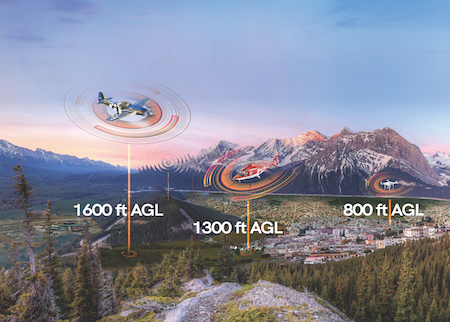Swiss company INVOLI promotes the idea that the data feeding the system is the key to a solid UTM implementation, which would allow pilots – of both manned and unmanned aircrafts – as well as air traffic controllers – to work together seamlessly for safer flights.

Cristina Mihalachioiu, co-founder and Legal & Communication at INVOLI, spoke to the Robotics Law Journal about UTM
RLJ: Can you give me a brief history of INVOLI?
Cristina Mihalachioiu: INVOLI is a young company, founded by friends who believe in thinking outside the box as a mantra for doing business. This is how the idea was born and this is how the organisation works. While combining very diversified competencies and personalities, the team is held together by shared principles like professionalism, respect and making the workplace a fun place.
RLJ: What is UTM and why is it important?
CM: UTM is a very new concept in the drone world; it stands for UAV traffic management, where UAV, in its turn, stands for “unmanned aerial vehicle”. In simpler words, drone traffic management – like airplane traffic control, but for drones. And in Europe it is actually named “U-Space”, despite the larger scale use of the US born term “UTM”. UTM has become very important in the past couple of years, along with the advances in the development of drones, the number of which has experienced exponential growth, opening the door for previously unthinkable commercial applications: survey, mapping, agriculture, video, search & rescue, etc. On top of this, these flying robots have the potential and the technical capabilities to perform autonomous missions.
In this context, millions of drones are expected in the coming years and this has resulted in new problems for aviation: how to safely integrate them into the current architecture of the sky? And the obvious reply was the new concept of UTM. Besides other challenges that need to be addressed to make the drone related SF scenarios come true, it became obvious the need for drone management: without traffic management, the drone revolution won’t be possible. Furthermore, UTM will not be truly possible without comprehensive air traffic data.
RLJ: What regulatory hurdles does implementing UTM face?
CM: In a nutshell: the lack thereof. Today, there is no unified legislation for UTM and common general principles for the regulation of drones have only just been approved by the European Parliament. The relevant regulation at an EU level will come out mid-next year. All this, in a context where manned aviation has aligned rules all over the world, which has made possible the aviation world as we know it. For the time being, integration of drones is subject to different rules depending on the country. For example, drones can’t fly around airports and normally UTM should have restrictions embedded. However, currently, the range of the flight restriction for France is 10km, for Switzerland 5km, for Germany 1.5 km and for UK 1 km; preferably, these should be included in any UTM system. This is only an example of where regulations currently are in terms of variations, which makes drone flights difficult for an international company that will have missions all over the world.
Moreover, for now, drone flights Beyond Visual Line of Sight (BVLoS) are subject to a complicated authorisation processes, if not virtually impossible in some countries, while such type of flights are the core of the large scale commercial use of drones. This is why enabling of BVLoS is the dream of the industry and everyone is looking at the lawmakers to issue rules flexible enough to allow BVLoS, but rigid enough to ensure safety.
RLJ: What are the technical challenges of UTM?
CM: It is fair to say that the actual technical challenges of UTM will be better known when the flying drones will be in the range of millions: it’s like with cars, until a significant number of cars of a particular model reach a certain number of kilometres, any conclusion is temporary. However, there are some issues which can be already named and settled. One of these issues is the lack of comprehensive low altitude air traffic data, so valuable for drones to have the necessary flight awareness for safe flights – this is how INVOLI was born and what INVOLI is solving today. Another technical challenge would relate to the communication between the drone, the controller and the UTM application, which is thoroughly considered by the drone manufacturing industry and hopefully successful results will be soon shared with the interested actors.
RLJ: How does INVOLI’s system work and why is it the “missing part” of UTM?
CM: At INVOLI, we are providing air traffic data to drones, data gathered through a network of in-house developed detection devices, deployed as a network covering a designated area. The identification signals thus detected are ADS-B and transponder mode S and, in some areas, FLARM, while non-cooperative aircraft detection is under development. Currently, we have a proof of concept with Swisscom consisting in the deployment of devices throughout Western Switzerland, covering an area of approximately 8,000 square km.
Air traffic data is essential for safe drone flights, drones being otherwise (generally) blind to what’s around them. Even more important, comprehensive low altitude air traffic data is crucial, as this data is not available elsewhere – while higher altitude flying aircraft or airplanes within the range of airport radars are easily detected by ATM today, there is not that much data for the rest, which makes drone flights not that safe. For example, drone delivery of blood between hospitals located outside the controlled airspace faces the struggle of incoming rescue helicopters whose arrival is not known in advance. This can be so easily solved with our data: the drone (pilot) gets to see the incoming helicopter in advance and avoid any collision risk. Our system, our air traffic data is giving drones a full view of the sky, enabling automatic collision avoidance algorithms and making it so easy to keep the sky safe while integrating drones into today’s aviation world.
RLJ: How quickly can UTM be widely implemented globally?
CM: With aligned regulations, that can be achieved pretty fast. The industry is far ahead in terms of technical capabilities, all that’s needed is clear, unified regulations. From a technical point of view, there is already an initiative of an unified UTM globally, with major actors finding the path to collaborate in a similar manner telecommunication companies do it today: clients of one UTM solution to be able to use data from the others depending on the territory where they are operating.
While the industry is ready, the level of education of the population as to the benefits of using drones and perceiving them as friendly machines still remains variable from one country to another and from one region to another. It rest on the industry in the end to make the relevant efforts to socially integrate these flying robots into the day-to-day routine of individuals and the challenges faced to this end will depend on each country’s culture. They say this industrial revolution is more about social revolution than anything, so we have very interesting times ahead of us.
RLJ: What needs to happen with regards to legislation/regulation to efficiently implement UTM?
CM: The answer is simple: UTM needs for regulations to be unified, and such regulations should regulate flights and allow (automatic) drone missions and not further restrict them. Moreover, coming regulations should be flexible enough to enable technology growth and, of course, competition, which is the basis of a healthy economy, as drones can change the way the world functions today and not in a bad way. Regulations need to keep an open mind, in the end. It is most important to allow the future to happen today.


.jpg)
.jpg)
.jpg)

.jpg)




